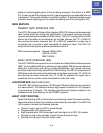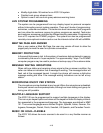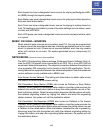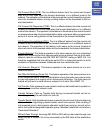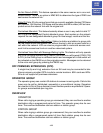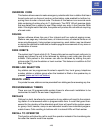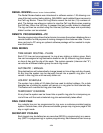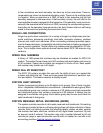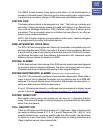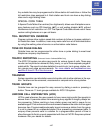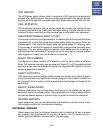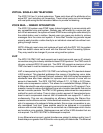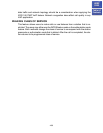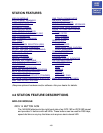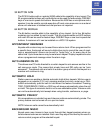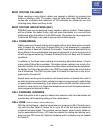
The SMDR format contains many options that allow it to be customized for a
company’s individual needs. Options to print include incoming calls, outgoing calls,
in and out of group status, change in DND status and authorization codes.
STATION PAIR
This feature allows station to be assigned as a “pair”. That is to say a primary and
secondary. Calling the primary station will make both stations ring. Selected fea-
tures such as Message Notification, DND, Callback, and Class of Service act as
one station. This is convenient when an individual has two offices or an office ex-
tension and a cordless extension.
NOTE: Not all system features are applicable to station pairs. Features designed
for a single user may conflict with paired stations.
SVMi–INTEGRATED VOICE MAIL
The iDCS 100 can be equipped with Samsung’s proprietary intergrated voice mail
and auto attendant card (SVMi). It provides 4–8 ports of voice processing. Because
it is built into the system it provides such feature as one touch Call Record, Answer-
ing Machine Emulation and Voice Mailbox Administration with interactive keyset
displays. Ask your dealer for literature on SVMi.
SYSTEM ALARMS
A DISA alarm will warn the customer if the DISA security system has been triggered
by too many incorrect password attempts. The alarm can ring any station or group
of stations and show an appropriate display at the assigned stations.
SYSTEM MAINTENANCE ALARMS (Enhanced Version Software/MEM4 Only)
The iDCS 100 continuously performs internal system diagnostics. When either a
major or minor fault is detected the system can ring stations with an ALARM KEY
assigned. The keyset display shows information that includes the description, lo-
cation and date and time stamp for each alarm.
A log of 100 alarms are stored in a buffer and can be reviewed at a display keyset
or sent to a printer (see sample Alarm Report in section 4.11 of this document).
SYSTEM DIRECTORY
Each station, station group and outside line can have an 11 character directory
name. This name will appear on keyset displays to provide additional information
about lines and stations.
TOLL RESTRICTION
There are 250 allow and 250 deny entries of 11 digits each. Each of these entries
can apply to dialing classes B, C, D , E, F and G. Expensive 976, 1-900, 411 and
operator-assisted calls, as well as specific area and office codes, can be allowed
or denied on a per-class basis. Class A stations have no dialing restrictions and
Class H stations cannot make outside calls.
4.26
HOME
PAGE
Table of
Contents



